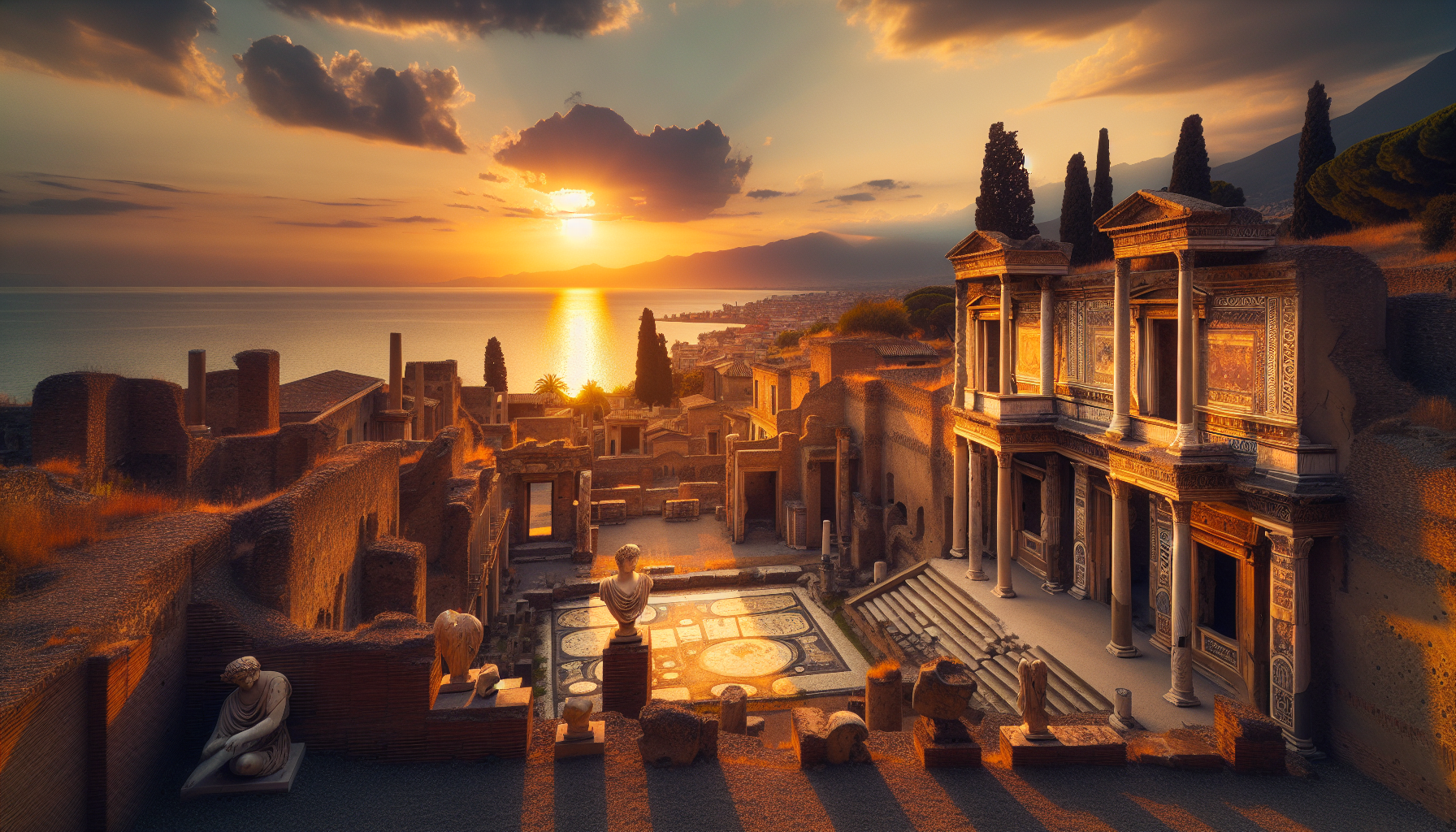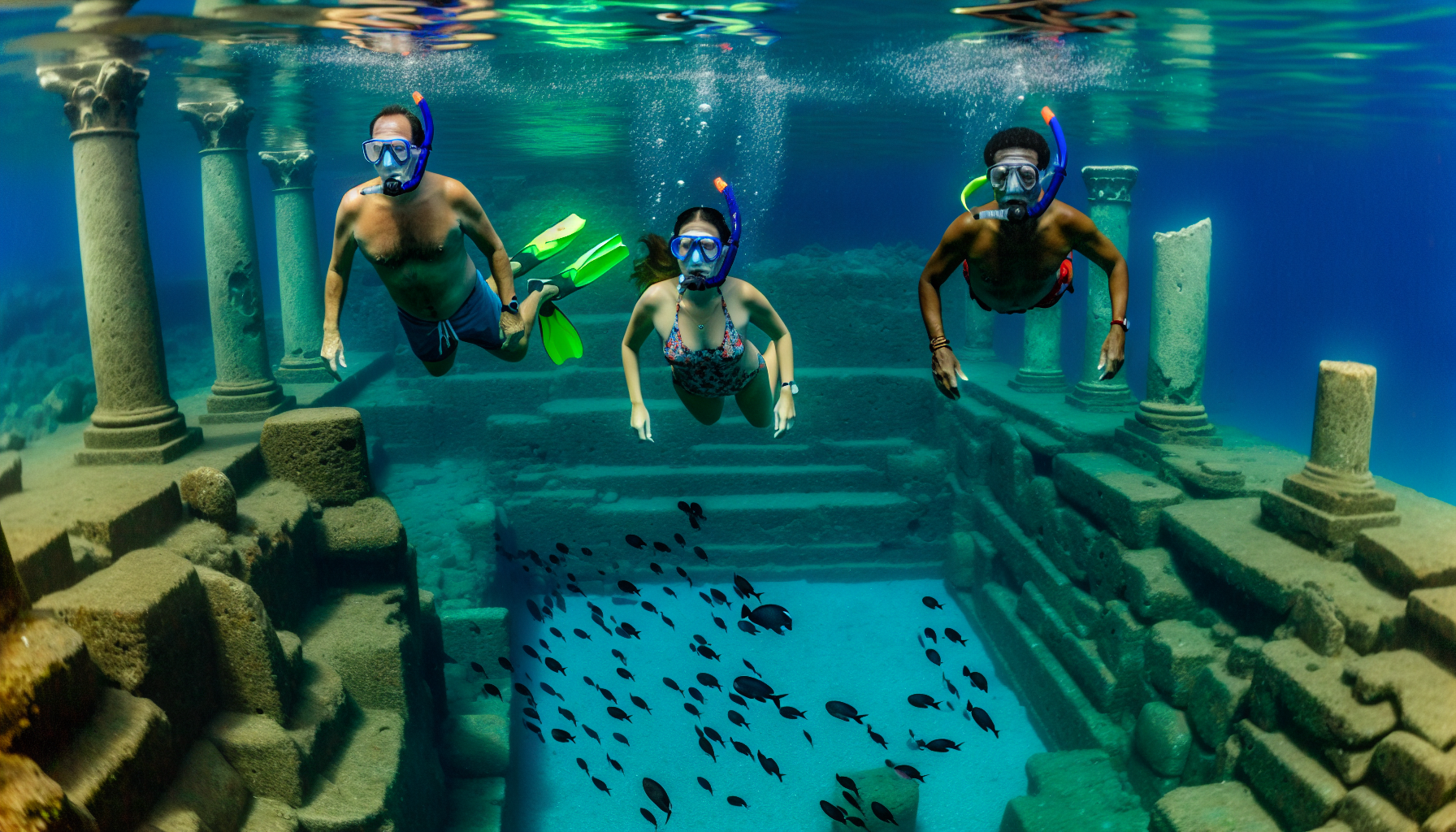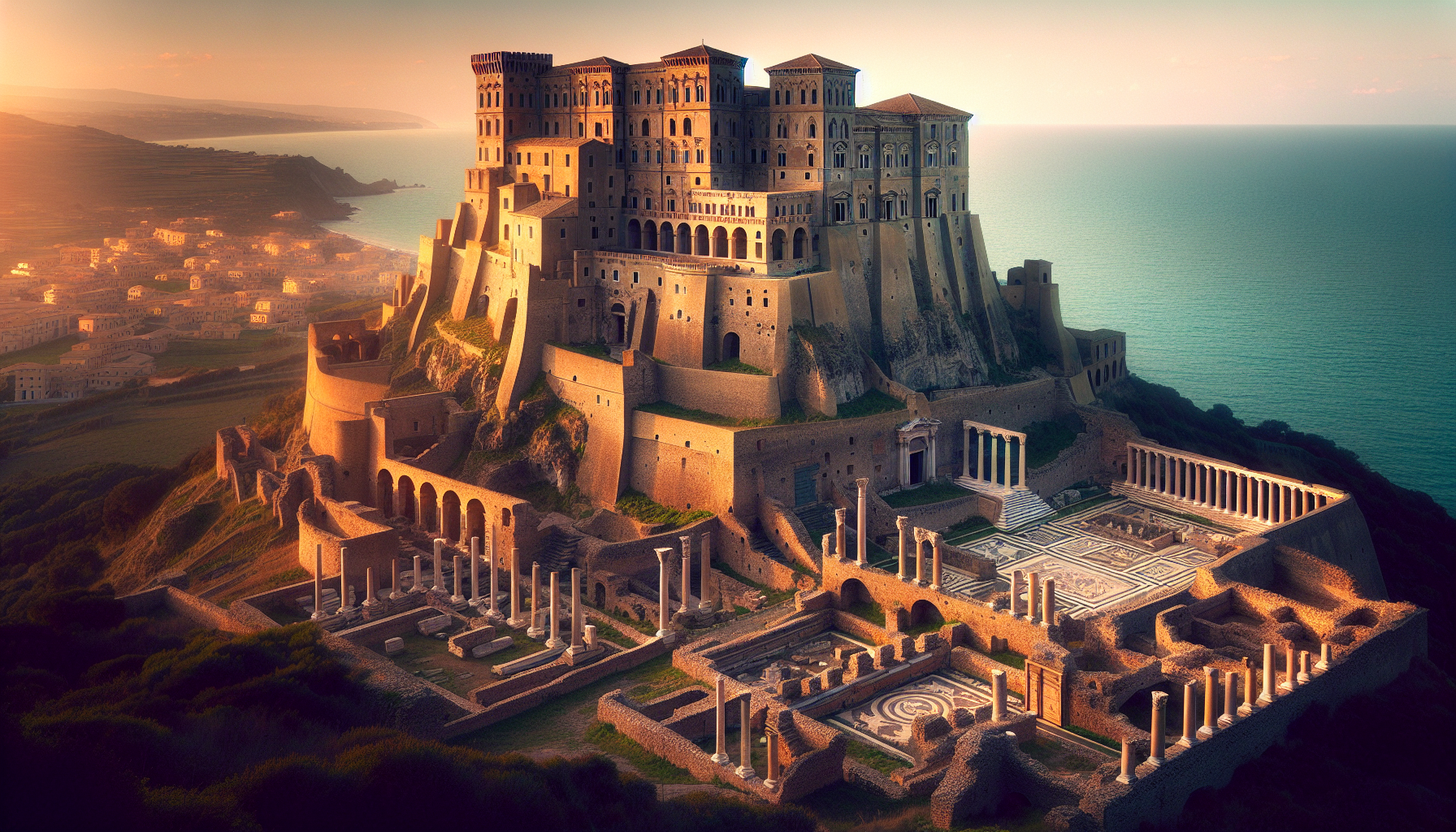Why did Baiae, a symbol of Roman luxury, end up beneath the waves? In this article, uncover the secrets of Baiae’s transformation from elite resort to submerged archaeological treasure. Discover its alluring history and how you can now witness its grandeur underwater or amidst its terrestrial ruins.
Key Takeaways
- Baiae was a prestigious retreat for ancient Rome’s elite, boasting luxurious villas and sophisticated bath complexes, which have become submerged ruins and are now part of the Underwater Archaeological Park of Baia.
- Marine archaeologists work to preserve Baiae’s submerged ruins through environmental monitoring and protective structures, while on land, the Baia Castle and ancient villa ruins speak to the city’s historic architectural grandeur.
- The city’s history is marked by its rise as a luxurious resort, its fall due to natural geological phenomena and invasions, and its modern transformation into a site of archaeological interest and tourism with initiatives like the MUSAS Project.
Unveiling Baiae: A Glimpse into Ancient Italy’s Opulence

During its golden age, Baiae served as a luxurious retreat for the Roman elite. Located on the northwest shore of the Gulf of Naples, this ancient city was blessed with a mild climate and therapeutic hot springs, making it a popular resort from the latter half of the 2nd Century BC.
Luxurious villas, built by affluent Romans along the shoreline, added a touch of charm and opulence to Baiae. The architectural sophistication of the town was also evident in its structures, often misnamed as temples, which were actually elaborate bath complexes offering a blend of recreational and therapeutic experiences.
The Underwater City: Exploring Submerged Ruins

Over time, Baiae’s magnificent structures and ancient roads became submerged ruins. The Underwater Archaeological Park of Baia, established in 2002, protects these underwater archaeological sites, offering a unique diving experience to those brave enough to explore the ancient city’s watery grave. From beginners to advanced divers, everyone can marvel at the sunken ruins of this once opulent resort town, thanks to the guided dives provided by Subaia Campania Divers.
Snorkeling and scuba diving provide alternatives for those wishing to observe the grandeur of the submerged city without delving too deep. Accompanied by an expert guide, visitors can float above the ruins in a private grotto surrounded by the echoes of ancient Italy’s opulence beneath them.
Sunken Treasures Revealed
Covering over 177 hectares, Baiae’s underwater archaeological site unveils a multitude of sunken structures, each bearing testament to the city’s erstwhile splendor. As divers navigate through the eerie underwater structures, they encounter remnants of the city’s luxurious past, such as marble floors and columns, hinting at the grandeur that once was. These spectacular subterranean treasures offer a unique glimpse into a world long lost beneath the waves.
To preserve the original marble statues from further damage, replicas now stand in their place, offering a glimpse of the artistic mastery of the Roman era. These submerged sculptures act as silent guardians of Baiae’s history, contributing to the incredible underwater landscape.
Marine Archaeology in Action
The preservation and study of Baiae’s underwater ruins present a significant challenge. Marine archaeologists have been working tirelessly, deploying submarine sensors for environmental monitoring and installing protective structures around the delicate remnants of the city. These efforts aim to ensure the longevity of these underwater wonders for future generations of explorers and archaeologists.
The discovery of the imperial Nymphaeum was the result of the inaugural underwater archaeological excavation in the 1980s. Since then, continuous efforts have resulted in the creation of a detailed map of the city and the unearthing of more structural features and design elements, such as rare marbles and intricate floor patterns, broadening our understanding of Baiae’s appearance during its prime.
Above Ground Roman Ruins: Baiae’s Visible Legacy

Although the submerged ruins command significant attention, the ruins beneath Baiae’s above-ground remnants hold equal allure. The Baia Castle, originally a fortress built by the Aragonese on the site of an ancient villa believed to have belonged to Emperor Nero, stands as a testament to the city’s rich history. Over the centuries, the castle underwent architectural expansions and style evolution, reflecting the changing rulers and their influence.
The ancient ruins of villas scattered across the land surrounding Baia provide a glimpse into the sophisticated Roman architecture with intricate marble and colonnade features. Each ruin tells a tale of the city’s vibrant past, taking us back to a time when Baiae was a bustling resort town frequented by Rome’s nobility. As we explore these ancient ruins upwards, we can truly appreciate the grandeur and scale of these magnificent structures.
The Rise and Fall of a Resort Town
The transformation of Baiae from an elegant resort to a submerged city narrates a captivating saga of ascension and fall. The city’s decline was a result of bradyseism, the gradual rise and fall of the Earth’s surface due to hydrothermal and seismic activity. This natural phenomenon caused much of Baiae to sink, disappearing beneath the waves, similar to the peppered west coast regions affected by tectonic movements.
The city’s fate was sealed by a Muslim invasion in the 8th century, which led to its further decline. The same volcanic activity that once attracted the Roman elite with its therapeutic hot springs and lime and volcanic rock eventually contributed to Baiae’s abandonment and submersion by 1500.
Baiae’s Sinful Reputation and Cultural Impact
Despite its demise, Baiae’s infamy as a center of hedonism and extravagance endures. It was often likened to the Las Vegas of the Roman Empire, attracting not just the elite, but also figures of intrigue and scandal. Seneca the Younger dubbed it a ‘vortex of luxury’ and a ‘harbour of vice,’ a testament to the city’s notoriety.
From Cleopatra’s escape after Julius Caesar’s assassination to Julia Agrippina’s plot for her son Nero, Baiae was a backdrop for scandalous tales, including those involving Julius Caesar, that captivated the public imagination. Its allure extended to notable Romans such as Cicero and the naturalist Pliny, who maintained residences in the city, further cementing its cultural impact and allure.
Modern Baia: From Ancient Splendor to Tourist Hub
Presently, initiatives are underway to reignite interest in Baiae’s illustrious history and submerged heritage. The MUSAS Project advocates for the protection and virtual exploration of these submerged treasures, fostering modern engagement with the ancient site.
The 16th-century Castello di Baia, now housing the Archaeological Museum of the Campi Flegrei, showcases regional archaeological finds, reflecting the area’s rich historical and archaeological narrative. There are expansive plans to grow the museum within the castle, ensuring that Baiae’s legacy continues to captivate the modern world.
The Echoes of History: Temples and Villas
An exploration of Baiae wouldn’t be complete without examining its renowned temple complexes and majestic villas. These archaeological wonders showcase the opulence and architectural prowess of the Roman Empire, echoing the city’s ancient splendor.
The Famed Temple Complexes
Often mistaken for temples, the sophisticated domed structures of Mercury, Venus, and Diana served as parts of thermal bath complexes, reminiscent of the ancient Greeks’ architectural prowess. They displayed the Roman’s engineering supremacy, with airy domes providing a recreational sanctuary for the elite – not a temple, but a place for relaxation and leisure.
These complexes were more than just architectural marvels. They offered recreational enjoyment, symbolizing luxury and pleasure with their lush surroundings. Their existence was central to social and cultural life in the Roman Empire, serving as a testament to their architectural grandeur.
The Grandeur of Ancient Villas
Magnificent villas, constructed in Baiae by affluent Romans, emperors, and consuls, highlighted their architectural expertise and the wealth they embodied. The villas featured a variety of architectural types, rich marble flooring, and panoramic views of the gulf.
The Villa of the Ambulatio, for example, offered stunning views of the gulf through its six terraces. Emperors and Roman consuls, such as Septimius Severus and the wealthy consul Symmachus, owned villas in Baiae, reinforcing its attractiveness to the most powerful individuals of Rome.

In the current digital era, the exploration of Baiae’s submerged ruins has ventured into a fresh dimension. Marine archaeologists use optical and acoustic techniques to create detailed digital terrain models of these sites, enhancing virtual tourism experiences.
Visitors to the submerged park at Baiae can also contribute to the preservation of these archaeological wonders. The admission fee paid for each dive goes towards conservation efforts, ensuring that the city’s underwater heritage continues to fascinate future generations of explorers.
Summary
From its rise as a luxurious resort town in ancient Rome to its fall into the sea, Baiae’s story is as captivating as it is poignant. Despite its watery grave, the city’s opulent legacy lives on, both in its underwater ruins and in the tales of its notorious past. Today, thanks to modern technology and conservation efforts, the grandeur of Baiae continues to captivate us, reminding us of the ephemeral nature of human achievements and the enduring power of history.
Frequently Asked Questions
What is the history of the Baiae?
Baiae, also known as the “Las Vegas of the ancient world,” was a hedonistic resort town for wealthy Roman elites situated about 150 miles south of Rome, on the slopes of the Campi Flegrei supervolcano, with its initial attraction being its hot springs. It was a popular destination for poets, generals, and other influential figures more than 2,000 years ago.
What is the underwater city in Rome?
Baia was an elite Roman getaway destination with opulent villas such as those of Caesar and Nero. Today, the city lies submerged beneath the waves.
Why is Baiae underwater?
Baiae is underwater due to bradyseismic activity, a process causing the earth’s surface to fall due to underground magma chambers. This phenomenon, not earthquakes, made the ground move downward, leading this ancient resort to submerge below the sea.
What is the MUSAS Project?
The MUSAS Project aims to protect and virtually explore Baiae’s underwater heritage, promoting contemporary interaction with the historic location.
How can I explore the underwater ruins of Baiae?
You can explore the underwater ruins of Baiae by taking part in diving or snorkeling experiences offered at the Archaeological Marine Park of Baia. If you don’t have diving experience, you can also opt for the ‘Try Scuba’ program.
